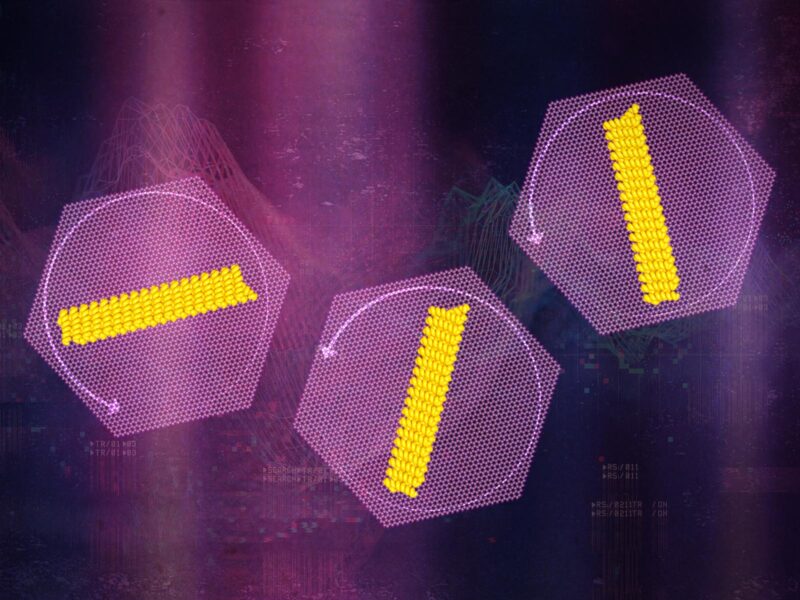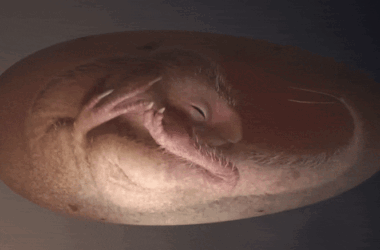
Une nouvelle recherche a suivi des protéines en rotation sur une surface minérale, identifiant des mouvements inattendus. Crédit : Illustration de Stephanie King Pacific Northwest National Laboratory
Une meilleure compréhension du mouvement des protéines peut faciliter la conception de matériaux avancés.
Les matériaux biologiques tels que les os, les dents et les coquillages sont extrêmement durables. Leur force provient de leur composition, qui consiste en un mélange de minéraux durs comme la roche et de composés résilients à base de carbone comme les protéines. Les spécialistes des matériaux s’inspirent des matériaux biologiques pour développer une nouvelle génération de matériaux avancés à base de protéines et de minéraux. Toutefois, les scientifiques doivent d’abord savoir comment les protéines se fixent et s’assemblent sur les surfaces minérales.
Les protéines sont un type clé de grande molécule organique biologiquement pertinente, essentielle à la vie sur Terre. Outre les protéines d’origine naturelle, les chercheurs peuvent créer des protéines sur mesure présentant des caractéristiques, des structures et des propriétés spécifiques. Ils peuvent notamment concevoir des protéines capables de se fixer à différentes surfaces, y compris des minéraux comme le mica. Le contrôle et la compréhension de la fixation des protéines sont essentiels à l’assemblage de matériaux bio-inspirés avancés.
Une équipe de chercheurs du Pacific Northwest National Laboratory (PNNL), du University of Washington (UW), and Lawrence Berkeley National Laboratory (Berkeley Lab) worked together to track how specially designed protein nanorods moved on a mica surface. Their findings were recently published in the Proceedings of the National Academy of Science. The team created a series of different-sized protein nanorods specifically designed to bind to mica in partnership with the University of Washington’s Institute for Protein Design. The researchers then employed high-speed microscopy to see individual nanorods rotate in real-time.
“We were able to track the protein nanorods at unprecedented levels of resolution,” said Shuai Zhang, a Research Assistant Professor in the Department of Materials Science & Engineering at UW who has a joint appointment with PNNL. “The atomic force microscope we used is incredibly powerful, allowing us to see individual molecule movements in real-time.”
To accurately observe protein rotation, the researchers had to study the protein-mica system in water. This environment mimics the conditions of protein assembly on real mineral surfaces.
Understanding different motion
Observing the system under a microscope produced massive quantities of data. The sheer volume of data made it challenging to analyze. The team at Berkeley Lab solved that problem by developing a new machine-learning algorithm that dramatically decreased the time needed to process the images. From there, the researchers were able to look at how fast the proteins moved and how far they were rotating per individual move.
Their observations showed that the proteins mostly behaved as expected, i.e., moved by making small jumps, following a model of motion traceable back to Einstein. However, the proteins occasionally made large, rapid jumps that the model couldn’t explain.
To get to the bottom of these different types of motion, the team performed simulations based on the microscopy data. They found that the energy of the protein-surface bond controlled how the proteins could rotate. Most of the time the proteins remain strongly bound to the mica surface, only able to make small motions. Occasionally they appear to briefly detach from the mica. During those short periods of time, the proteins can move quickly in large jumps.
“Comparing our observational data and simulations allowed us to identify both types of protein motion,” said Ben Legg, a chemist at PNNL. “We think that the large jumps have important consequences for assembling protein-mineral structures.”
Understanding how individual biological molecules move can help researchers develop better methods to assemble large numbers of proteins on surfaces.
This work was funded by the Department of Energy through the Center for the Science of Synthesis Across Scales and the Scientific Discovery through Advanced Computing (SciDAC) program. The PNNL research team also included James De Yoreo. The UW team included Harley Pyles and David Baker. The Berkeley Lab team consisted of Robbie Sadre, Talita Perciano, E. Wes Bethe, and Oliver Rübel.
Reference: “Rotational dynamics and transition mechanisms of surface-adsorbed proteins” by Shuai Zhang, Robbie Sadre, Benjamin A. Legg, Harley Pyles, Talita Perciano, E. Wes Bethel, David Baker, Oliver Rübel and James J. De Yoreo, 11 April 2022, Proceedings of the National Academy of Science.
DOI: 10.1073/pnas.2020242119



